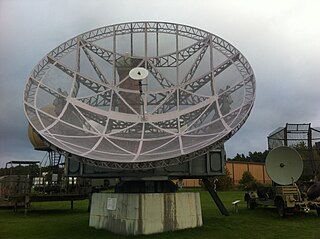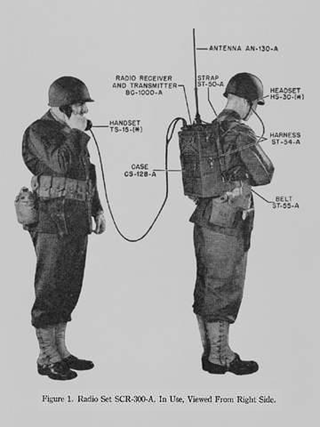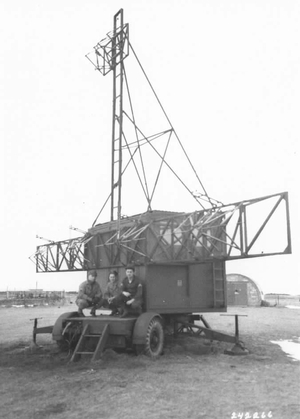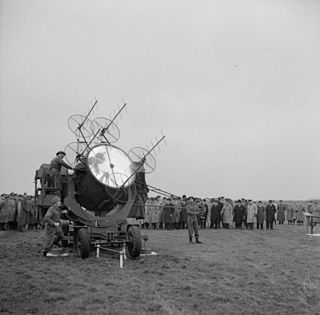Related Research Articles

The low-UHF band Würzburg radar was the primary ground-based tracking radar for the Wehrmacht's Luftwaffe and Kriegsmarine during World War II. Initial development took place before the war and the apparatus entered service in 1940. Eventually, over 4,000 Würzburgs of various models were produced. It took its name from the city of Würzburg.

The SCR-268 was the United States Army's first radar system. Introduced in 1940, it was developed to provide accurate aiming information for antiaircraft artillery and was also used for gun laying systems and directing searchlights against aircraft. The radar was widely utilized by both Army and Marine Corps air defense and early warning units during World War II. By the end of World War II the system was already considered out of date, having been replaced by the much smaller and more accurate SCR-584 microwave-based system.

The SCR-584 was an automatic-tracking microwave radar developed by the MIT Radiation Laboratory during World War II. It was one of the most advanced ground-based radars of its era, and became one of the primary gun laying radars used worldwide well into the 1950s. A trailer-mounted mobile version was the SCR-784.

The 120 mm Gun M1 was the United States Army's standard super-heavy anti-aircraft gun during World War II and the Korean War, complementing the smaller and more mobile M2 90 mm gun in service. Its maximum altitude was about 60,000 ft (18,000 m), which earned it the nickname stratosphere gun.

Signal Corps Radios were U.S. Army military communications components that comprised "sets". Under the Army Nomenclature System, the abbreviation SCR initially designated "Set, Complete Radio", but was later misinterpreted as "Signal Corps Radio."

The Radiation Laboratory, commonly called the Rad Lab, was a microwave and radar research laboratory located at the Massachusetts Institute of Technology (MIT) in Cambridge, Massachusetts. It was first created in October 1940 and operated until 31 December 1945 when its functions were dispersed to industry, other departments within MIT, and in 1951, the newly formed MIT Lincoln Laboratory.
Signal Corps Laboratories (SCL) was formed on June 30, 1930, as part of the U.S. Army Signal Corps at Fort Monmouth, New Jersey. Through the years, the SCL had a number of changes in name, but remained the operation providing research and development services for the Signal Corps.
Radar in World War II greatly influenced many important aspects of the conflict. This revolutionary new technology of radio-based detection and tracking was used by both the Allies and Axis powers in World War II, which had evolved independently in a number of nations during the mid 1930s. At the outbreak of war in September 1939, both Great Britain and Germany had functioning radar systems. In Great Britain, it was called RDF, Range and Direction Finding, while in Germany the name Funkmeß (radio-measuring) was used, with apparatuses called Funkmessgerät . By the time of the Battle of Britain in mid-1940, the Royal Air Force (RAF) had fully integrated RDF as part of the national air defence.

Radar, Airborne Interception, Mark VIII, or AI Mk. VIII for short, was the first operational microwave-frequency air-to-air radar. It was used by Royal Air Force night fighters from late 1941 until the end of World War II. The basic concept, using a moving parabolic antenna to search for targets and track them accurately, remained in use by most airborne radars well into the 1980s.

Radar, Gun Laying, Mark I, or GL Mk. I for short, was an early radar system developed by the British Army to provide range information to associated anti-aircraft artillery. There were two upgrades to the same basic system, GL/EF and GL Mk. II, both of which added the ability to accurately determine bearing and elevation.

Radar, Anti-Aircraft Number 3 Mark 7, also widely referred to by its development rainbow code Blue Cedar, was a mobile anti-aircraft gun laying radar designed by British Thomson-Houston (BTH) in the mid-1940s. It was used extensively by the British Army and was exported to countries such as Holland, Switzerland, Sweden Finland and South Africa. In British service, it was used with the 5.25 inch and QF 3.7 inch AA guns, as well as the Brakemine missile.

Radar, Gun Laying, Mark III, or GL Mk. III for short, was a radar system used by the British Army to directly guide, or lay, anti-aircraft artillery (AA). The GL Mk. III was not a single radar, but a family of related designs that saw constant improvement during and after World War II. These were renamed shortly after their introduction in late 1942, becoming the Radar, AA, No. 3, and often paired with an early warning radar, the AA No. 4, which was also produced in several models.

IFF Mark II was the first operational identification friend or foe system. It was developed by the Royal Air Force just before the start of World War II. After a short run of prototype Mark Is, used experimentally in 1939, the Mark II began widespread deployment at the end of the Battle of Britain in late 1940. It remained in use until 1943, when it began to be replaced by the standardised IFF Mark III, which was used by all Allied aircraft until long after the war ended.

Searchlight Control, SLC for short but nicknamed "Elsie", was a British Army VHF-band radar system that provided aiming guidance to an attached searchlight. By combining a searchlight with a radar, the radar did not have to be particularly accurate, it only had to be good enough to get the searchlight beam on the target. Once the target was lit, normal optical instruments could be used to guide the associated anti-aircraft artillery. This allowed the radar to be much smaller, simpler and less expensive than a system with enough accuracy to directly aim the guns, like the large and complex GL Mk. II radar. In 1943 the system was officially designated Radar, AA, No. 2, although this name is rarely used.

The AMES Type 82, also widely known by its rainbow codename Orange Yeoman, was an S-band 3D radar built by Marconi and used by the Royal Air Force (RAF), initially for tactical control and later for air traffic control (ATC).
Radar, Air-to-Surface Vessel, or ASV radar for short, is a classification used by the Royal Air Force (RAF) to refer to a series of aircraft-mounted radar systems used to scan the surface of the ocean to locate ships and surfaced submarines. The first examples were developed just before the opening of World War II and they have remained a major instrument on patrol aircraft since that time. It is part of the wider surface search radar classification, which includes similar radars in ground and ship mountings.

132nd (Mixed) Heavy Anti-Aircraft Regiment was an air defence unit of Britain's Royal Artillery formed during World War II. It was one of the first 'Mixed' regiments in which women of the Auxiliary Territorial Service were integrated into the unit's personnel. It defended London and South-East England against aerial attack until it deployed to Belgium in January 1945 to defend Brussels against V-1 flying bombs.

435th (Mixed) Heavy Anti-Aircraft Battery was an air defence unit of Britain's Royal Artillery formed during World War II. It was the first 'Mixed' battery in which women of the Auxiliary Territorial Service were integrated into the unit's personnel and was the forerunner of hundreds of later batteries. It defended the United Kingdom against aerial attack until it deployed to Belgium in January 1945 to defend Brussels against V-1 flying bombs.

The SCR-720 was a World War II Airborne Interception radar designed by the Radiation Laboratory (RadLab) at MIT in the United States. It was used by US Army Air Force night fighters as well as the Royal Air Force (RAF) in a slightly modified version known as Radar, Airborne Interception, Mark X, or AI Mk. X for short.
References
- "List of AA Radar Types". Anti-Aircraft.